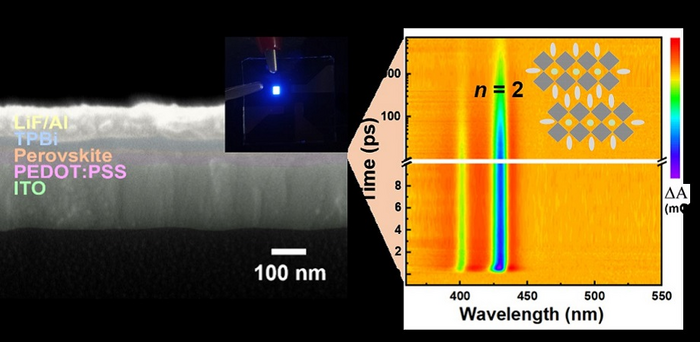The deep blue of your LED display is likely produced by indium gallium nitride (InGaN), a costly substance. In the field of LEDs, researchers are seeking alternatives in a type of perovskite known as quasi-2D Ruddlesden‒Popper perovskites (2D-RPPs). 2D-RPPs have excellent optoelectronic properties – ideal for LEDs. Although 2D-RPP-based LEDs have rapidly progressed in terms of performance, it is still challenging to demonstrate blue-emissive and color-pure LEDs.

Credit: J. Moon, Yonsei University.
The deep blue of your LED display is likely produced by indium gallium nitride (InGaN), a costly substance. In the field of LEDs, researchers are seeking alternatives in a type of perovskite known as quasi-2D Ruddlesden‒Popper perovskites (2D-RPPs). 2D-RPPs have excellent optoelectronic properties – ideal for LEDs. Although 2D-RPP-based LEDs have rapidly progressed in terms of performance, it is still challenging to demonstrate blue-emissive and color-pure LEDs.
Conventional fabrication processes for producing 2D-RPP films (e.g., hot-casting and antisolvent dripping) induce spatial segregation of the chemical species during the film crystallization. The resulting mixed perovskite phases evoke the emission from perovskite phase with a smaller bandgap, which hinders deep-blue emissions. A strategy capable of precisely controlling the phase evolution of the 2D-RPPs during crystallization is required to achieve deep-blue LEDs.
As reported in Advanced Photonics, researchers from Yonsei University and Sungkyunkwan University in Korea recently proposed a rapid crystallization method to manipulate the 2D perovskite phase evolution by controlling the crystallization kinetics for the fabrication of phase-pure 2D-RPPs, enabling deep-blue-emissive perovskite LEDs. When the as-spin-coated precursor wet film was submerged in a hot-bath of diethyl ether, immediate crystallization occurred, due to the rapid extraction of precursor solvent by diethyl ether. Extremely fast crystallization kinetics allowed all the chemical species to be randomly distributed throughout the film, successfully yielding highly phase-pure 2D-RPP crystals.
Steady-state photoluminescence and ultrafast transient absorption clearly revealed that rapid crystallization via hot-antisolvent bathing enables highly phase-pure 2D perovskite films with randomly oriented crystals. The random orientations of the 2D perovskite crystals enhanced charge transport and improved charge mobility to benefit device performance. The resulting deep-blue-emissive perovskite LEDs exhibited a maximum external quantum efficiency (EQE) of 0.63% with an emission wavelength centered at 437 nm. Prolonged stability of the unencapsulated PeLEDs was further confirmed with negligibly changed EL spectra, highly comparable to those of state-of-the-art devices.
According to senior author Jooho Moon, professor in the Department of Materials Science and Engineering at Yonsei University, “This work provides a novel approach to realize high performance and spectrally stable deep-blue perovskite LEDs. Our research suggests that the control of the crystallization kinetic is the key for the preparation of phase-pure 2D-RPP crystals, exhibiting great promise for addressing current challenges.”
Read the Gold Open Access article by G. Jang et al., “Rapid crystallization driven high-efficiency phase-pure deep-blue Ruddlesden‒Popper perovskite light-emitting diodes,” Adv. Photon. 5(1), 016001 (2023), doi 10.1117/1.AP.5.1.016001.
Journal
Advanced Photonics
DOI
10.1117/1.AP.5.1.016001
Article Title
Rapid crystallization-driven high-efficiency phase-pure deep-blue Ruddlesden–Popper perovskite light-emitting diodes
Article Publication Date
4-Jan-2023




